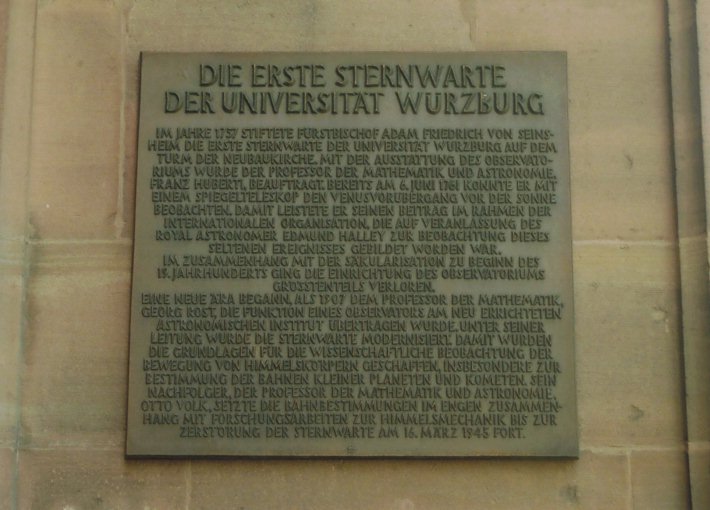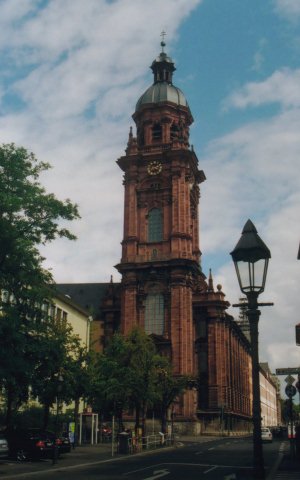

![]() Etwas versteckt an der Nordseite des Turms der Neubaukirche in Würzburg befindet
sich eine Bronzetafel auf der die Geschichte der ersten Sternwarte der Universität
Würzburgs skizziert wird. Diese Tafel benennt auch die Mathematiker
Edmond
Halley,
Franz
Huberti,
Georg
Rost und
Otto
Theodor Volk.
Das Kirchengebäude befindet sich an der Kreuzung der Straßen Neubau-
und Schönthalstraße, steht heute im Eigentum der Universität und
wird als Aula genutzt.
Etwas versteckt an der Nordseite des Turms der Neubaukirche in Würzburg befindet
sich eine Bronzetafel auf der die Geschichte der ersten Sternwarte der Universität
Würzburgs skizziert wird. Diese Tafel benennt auch die Mathematiker
Edmond
Halley,
Franz
Huberti,
Georg
Rost und
Otto
Theodor Volk.
Das Kirchengebäude befindet sich an der Kreuzung der Straßen Neubau-
und Schönthalstraße, steht heute im Eigentum der Universität und
wird als Aula genutzt.
Die Tafel ist mit erhabenen Lettern gestaltet und zeigt den
 Text:
Text:
| Die erste Sternwarte der Universität Würzburg Im Jahre 1757 stiftete Fürstbischof Adam Friedrich von Seins- heim die erste Sternwarte der Universität Würzburg auf dem Turm der Neubaukirche. Mit der Ausstattung des Observato- riums wurde der Professor der Mathematik und Astronomie, Franz Huberti, beauftragt. Bereits am 6. Juni 1761 konnte er mit einem Spiegelteleskop den Venusvorübergang vor der Sonne beobachten. Damit leistete er seinen Beitrag im Rahmen der Internationalen Organisation, die auf Veranlassung des Royal Astronomer Edmund Halley zur Beobachtung dieses seltenen Ereignisses gebildet worden war. Im Zusammenhang mit der Säkularisation zu Beginn des 19. Jahrhunderts ging die Einrichtung des Observatoriums größtenteils verloren. Eine neue Ära begann, als 1907 dem Professor der Mathematik, Georg Rost, die Funktion eines Observators am neu errichteten Astronomischen Institut übertragen wurde. Unter seiner Leitung wurde die Sternwarte modernisiert. Damit wurden die Grundlagen für die wissenschaftliche Beobachtung der Bewegung von Himmelskörpern geschaffen, insbesondere zur Bestimmung der Bahnen kleiner Planeten und Kometen. Sein Nachfolger, der Professor der Mathematik und Astronomie, Otto Volk, setzte die Bahnbestimmungen im engen Zusammen- hang mit Forschungsarbeiten zur Himmelsmechanik bis zur Zerstörung der Sternwarte am 16. März 1945 fort. |
Bezüglich der Gesamtansicht auf der rechten Seite ist die Tafel auf der linken Seite des Turms zu finden.
Die Fotos wurden im August 2008 aufgenommen.
![]() Somewhat hidden at the northern side of the tower of the church Neubaukirche in the
city of Würzburg there is a bronze plaque which sketches the history of the first
observatory of the university of Würzburg. The text of this plaque also mentions the
mathematicians
Edmond
Halley,
Franz
Huberti,
Georg
Rost and
Otto
Theodor Volk.
The church is located at the crossroads of the streets Neubaustraße
and Schönthalstraße.
Nowadays the church itself is property of the university is used as great hall.
Somewhat hidden at the northern side of the tower of the church Neubaukirche in the
city of Würzburg there is a bronze plaque which sketches the history of the first
observatory of the university of Würzburg. The text of this plaque also mentions the
mathematicians
Edmond
Halley,
Franz
Huberti,
Georg
Rost and
Otto
Theodor Volk.
The church is located at the crossroads of the streets Neubaustraße
and Schönthalstraße.
Nowadays the church itself is property of the university is used as great hall.
| The first observatory of the University of Würzburg In the year 1757 the prince-bishop Adam Friedrich from Seinsheim donated the first observatory of the university of Würzburg which was established on the tower of the church Neubaukirche. To facilitate the observatory was the task of the professor for mathematics and astronomy Franz Huberti. Already on June 6th, 1761 he was able to obbey the Venus transit. Hence he contributed to the project of the International Organization, which was established by the Royal Astronomer Edmund Halley for this rare astromical event. Due to the secularization in the beginning of the 19th century the equipment of the observatory has gone lost. A new era began in 1907, when the professor for mathematics Georg Rost was appointed for the position of an observer at the new Astromical Institute. Under his leadership the observatory was modernized. This formed the basis for scientific observations of celestial objekts, especially for determining the orbits of planetoids and comets. His successor the professor for mathematics and astronomy Otto Volk continued the determination of orbits in connection with his scientific work on celestial mechanics up to the destroyment of the observatory on March 16th, 1945. |
For the total view of the church above on the right the plaque may be found on the left side of the tower.
The photographs were taken in August 2008.
| Back to the main page | Created by Wolfgang Volk in January 2010 Last correction on Januaryth, 20011 |